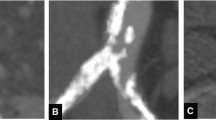In this study we sought to determine whether initial abdominal aortic aneurysm (AAA) sac anatomy, morphology, and side branch patency influence changes in aneurysm size and development of endoleak following endovascular repair. A blinded, retrospective review of preintervention CT scans and angiograms was conducted on 70 consecutive patients treated for infrarenal AAA (mean size 6.0 ± 0.8 cm) by AneuRx stent-graft exclusion. Initial AAA diameter and side branch (inferior mesenteric artery [IMA], lumbar artery pair) patency, AAA clot/sac diameter ratio, wall thrombus and calcification distributions, attachment site anatomy, endograft size, and other clinical parameters were correlated with postoperative persistent side branch patency, presence of type II endoleak, and change in AAA diameter (increase/decrease ? 5 mm) using contingency table analyses. Patients underwent CT scaning and/or color duplex imaging at 1 month and at 3 (with endoleak) or 6 (without) month intervals postoperatively with 50 patients followed beyond 6 months (mean follow-up 11 ± 7 months). The majority of patients possessed patent side branches prior to intervention (lumbar [n = 60, 86%], IMA [n = 45, 64%]). Development of type II endoleak or persistence of side branches could not be predicted (p > 0.05) from preoperative AAA side branch patency or any of the other initial anatomic AAA variables. On serial post-repair CT or duplex cans, 42% (19/45) of IMAs and 27% (16/60) of lumbar artery pairs remained patent. For patients followed beyond 6 months, type II endoleaks persisted in half (13/25) of the patients with patent side branches with roughly equal proportions fed by IMA and lumbar sources. Persistent side branches or presence of type II endoleak was associated with AAA expansion or the failure of aneurysm size diminution after endografting (p <0.01). Aneurysm sac regression was most likely in the absence of endoleak and patent side branches. We conclude that persistent side branch patency not only fuels development of type II endoleak but also influences early aneurysm sac behavior after endovascular repair. Optimal anatomic patient selection for endografting may not be possible on the basis of our initial experience, since preoperative AAA variables did not predict persistence of side branches or type II endoleaks.
Similar content being viewed by others
Author information
Authors and Affiliations
About this article
Cite this article
Back, M., Bowser, A., Johnson, B. et al. Patency of Infrarenal Aortic Side Branches Determines Early Aneurysm Sac Behavior after Endovascular Repair . Ann Vasc Surg 17, 27–34 (2003). https://doi.org/10.1007/s10016-001-0327-x
Issue Date:
DOI: https://doi.org/10.1007/s10016-001-0327-x




